With Etrian Odyssey 3 hitting North American retail shelves today, it seems like a good opportunity for a post on a subject near and dear to my heart – the surprising resurgence of what, for lack of a better term, I will call grid-based dungeon crawler RPGs on Nintendo’s handheld system.
What is a Grid-Based Dungeon Crawler RPG?
Before Ultima Underworld introduced the ability to move freely through a 3D space, first-person role playing games were strictly grid-based. Each time you pressed the arrow key left or right, you would turn a full 90 degrees in that direction. Each time you pressed the up arrow key, you advanced one square forward on an invisible grid. While this made mapping easy (graph paper was ideal) it also imposed artificial restraints on the dungeon designs. (These evil mages must have hired only the best dungeon contractors to get all of those 90 degree angles and perfectly level floors just right!)
This style of game first appeared in the earliest computer RPGs like Wizardry in 1981, matured in the Bard’s Tale series in the mid-1980s, and arguably reached its zenith with Dungeon Master (1987) and Eye of the Beholder (1990). With the advent of true, flowing 3D gameplay in Ultima Underworld in 1992, this style eventually became obsolete and croaked.
Every so often, I get a hankering to return to this old-fashioned RPG genre of my youth. For a long time, the only way to experience this style was to dig up a relic of the past and play it in Dosbox. However, the high levels of difficulty and archaic user interfaces of these games require the patience and fortitude of a truly dedicated CRPG Addict.
In the last few years, however, this situation has changed. The Nintendo DS has become the unlikely home of several grid-based dungeon crawler RPGs that recreate the old-school style with better graphics, better user interfaces, and somewhat easier difficulty curves.
The most well-known of these is probably the Etrian Odyssey series from Atlus and Lancarse, which debuted on the Nintendo DS in 2007. The Etrian Odyssey games go so far as to emulate not only the on-screen experience of playing an old grid-based dungeon crawler RPG, but also the off-screen experience of mapping the dungeons by hand on graph paper. (You draw and annotate the map using the stylus.) With the third installment of the series, Etrian Odyssey 3: The Drowned City, releasing today, I’m sure that future posts on this blog will delve into this series in detail. For this blog post, I would like to examine a few of the lesser known DS grid-based dungeon crawler RPGs, games like Etrian Odyssey – Orcs & Elves by id Software, The Dark Spire
by Success, and Shin Megami Tensei: Strange Journey
by Atlus and Lancarse (the same developers as the Etrian Odyssey games).
Orcs & Elves
Unlike the grid-based dungeon crawler RPGs of my youth, which were western RPGs developed by small teams or individuals in the United States and inspired primarily by Dungeons & Dragons, the new crop of grid-based dungeon crawler RPGs on DS are mostly from Japanese developers and draw their inspiration from less straightforward fantasy trappings.
The exception to this statement is Orcs & Elves, an RPG by John Carmack (yes, that John Carmack) supposedly inspired by his childhood experiences as a tabletop D&D dungeon master. The game is a tongue-in-cheek, lightweight RPG that plays kind of like a single-character (unless you count your talking wand) version of Dungeon Master – except for its weird turn-based aspect, discussed below.
Be warned – this game is a port of a cell phone game. Not an iPhone game. A cell phone game, made on the BREW platform back in the stone age of mobile game development when the Motorola Razr was considered hot stuff. Although the graphics are (slightly) updated on the DS version, they are still below average for the system – particularly the animation, which is sorely lacking in frames.
Also stemming from the technical limitations of its original platform is its turn-based movement system, which has more in common with Rogue than with The Bard’s Tale. Now, I am a fan of turn-based combat, which until Dungeon Master was a staple of grid-based dungeon crawler RPGs. But not turn-based everything. As in classic rogue-likes, in Orcs & Elves, the player makes a move, then everything else in the game makes a move, then everything pauses until the player moves again. This aspect of the game takes some getting used to.
Orcs & Elves is also very shallow when it comes to character creation. Basically, there is none. You are required to play as “Elli,” an elf warrior with a talking magic wand named “Ellon.” When you level up, skill points are automatically assigned without your input.
Finally, the game is exceedingly easy. On normal difficulty, I did not die once until the final boss battle. There are a few weapons that are game-breaking in their power – such as the Medusa scroll, which turns flesh-based enemies to stone and renders them defenseless as you bash their petrified brains out. There are some simplistic puzzles, and some basic strategy in connection with movement and the use of various potions, weapons, and spells, but this is definitely not an RPG for gamers seeking a challenge.
The Dark Spire
If challenge is what you want, you can’t go wrong with The Dark Spire. Developed by Success and published by Atlus in the United States in 2009, The Dark Spire is such a loving homage to old school grid-based dungeon crawler RPGs that it even offers an optional black-and-white “wireframe” mode that replicates the ancient graphics of Apple II era Wizardry.
Also replicated is the brutal difficulty, and opaque user interface, common in those old games. Aside from being portable, The Dark Spire offers no real advancements over the games that inspired it. An argument could be made that, if you are willing to put up with the frustration, the trial-and-error gameplay, and the bad graphics, you might as well play the real thing.
For those gamers eager and willing to meet its challenges, however, The Dark Spire offers gaming goodness not readily available on modern systems. The spare, dark graphics combine with the punishing difficulty to create an atmosphere of menace. The party-based character creation and development systems are deep and rewarding (you can even unlock a couple of new races). The turn-based combat is straight out of The Bard’s Tale and chockfull of tactical options. There is an auto-map, but it does not show your location and you can’t view it and move at the same time. One day I would like to really dig deep into this game – and if I do, I will devote an entire blog post to it.
Shin Megami Tensei: Strange Journey
Strange Journey, developed by Atlus and Lancarse and published by Atlus in the United States in 2010, is nominally part of the Shin Megami Tensei series of JRPGs – but aside from the demon summoning and fusion systems, the game bears more in common with the developer’s Etrian Odyssey games than with Shin Megami Tensei. They definitely got the name right. This journey is as strange as journeys get. It takes the grid-based dungeon crawler RPG to the south pole in an adventure that is part sci-fi, part horror, part Pokemon, and very Japanese.
You play the role of an American soldier who wears a ridiculous-looking costume called a Demonica suit (which is explained as an acronym for DEMOuntable Next Integrated Capability Armor – the game expects you to believe that the name of your gear and your appearance in a dimension full of demons is purely coincidental). Throughout the game, you can power up your suit with various equipment and abilities.
Like The Dark Spire and Etrian Odyssey, Strange Journey is party-based. However, you are the only permanent member of your party. The other slots are filled with demons that you either recruit through conversation or create through fusion. This aspect is more like Pokemon than a typical RPG, and the result is that you never really bond with your party members. They are all expendable, constantly being dumped for, or upgraded to, something better. You don’t really have a party – just a main character and a continuously changing roster of ridiculous looking pets. For me, this is a negative. I enjoy building up the stats and equipment of my party members, as opposed to collecting monsters. For other gamers who are more into collecting things, it might be a plus.
I need to lodge one complaint about the automap in Strange Journey – it is actually too good. Because of the lack of information on the main screen (enemies do not appear because encounters are random, doors are sometimes difficult to distinguish from walls) and the wealth of information on the automap (all doors, treasure chests, boss enemies, stairs and objectives are clearly marked), I found myself playing this game on the automap instead of the main screen. This is a shame. Considering Strange Journey has some of the best and most atmospheric graphics of the games discussed in this post, the fact that I spent most of my playtime staring at an arrow on a grid feels like wasted potential.
The turn-based combat is fun if a bit dry. It is sufficiently complex due to elemental and alignment variables and a neat mechanic by which you slowly identify each enemy’s strengths and weaknesses through repeated encounters. You can also talk your way out of a fight, which is unusual and welcome in a game with random encounters. Overall, Strange Journey is a strong RPG and a fun throwback to the old days, particularly if you are looking for something with more of a sci-fi vibe than Etrian Odyssey and the other games discussed here.
With the release of these and other games like Etrian Odyssey, the grid-based dungeon crawler RPG is enjoying a surprising comeback. The comeback may end when Nintendo’s follow-up to the DS arrives, so get in on the fun now, before the grid-based dungeon crawler RPG returns to the shadows of obsolescence.
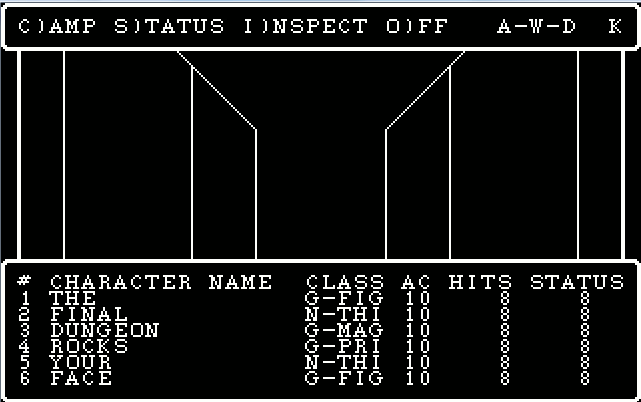
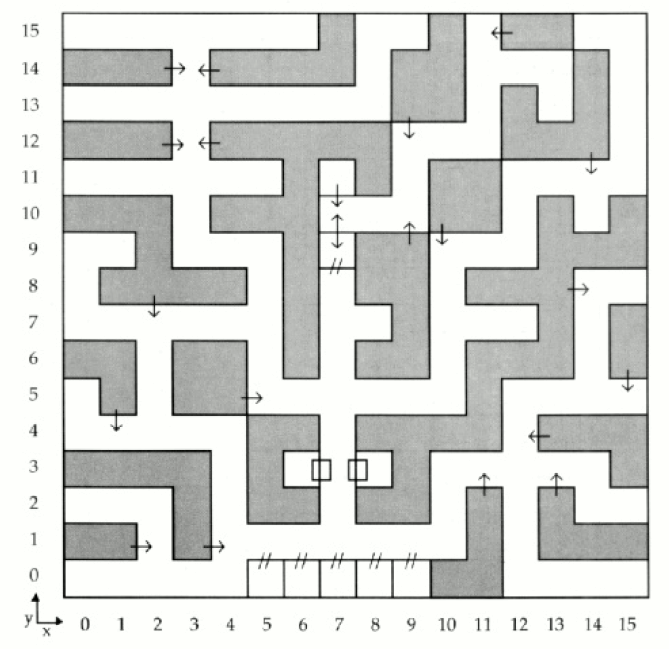
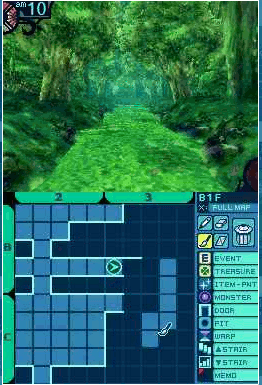
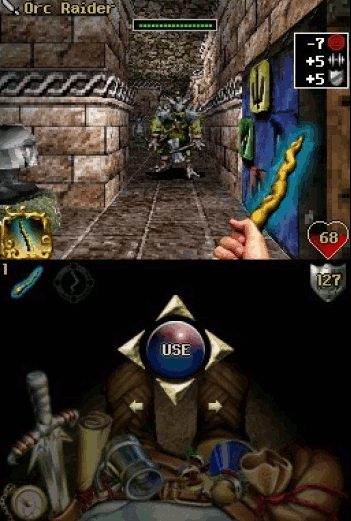
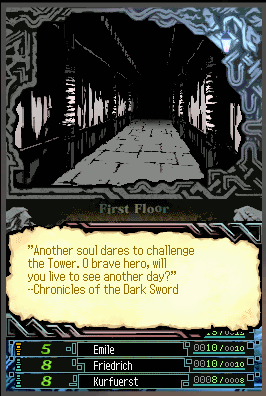
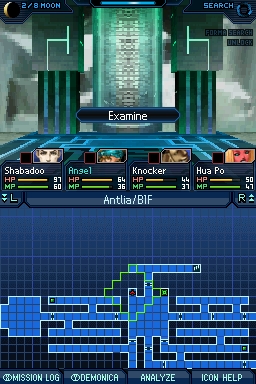
I’ve found the recent batch of DS dungeon crawlers a bit lacking overall. Etrian Odyssey was a bit odd due to the strange character development. Dark Spire *should* have been the one to suck me in with a lot of traditional game play designs, but the obscure puzzles annoyed me to much. I haven’t played Strange Journey yet, but having played other Shin Megami games in the past with similar concepts, I already have expectations (which isn’t necessarily a bad thing) when I finally do get it.
The PS2 has been my favourite for console dungeon crawlers. I’ve yet to find anything that comes close to Wizardry PSX in terms of modern grid-based dungeons. It took the right game play mechanics and applied it to today’s technology, which helped create a gloomy, but immersive environment.
Scrav, are you taking about Wizardry: Tale of the Forsaken Land on PlayStation 2? I have heard some good things about this game, but haven’t had a chance to try it.
I agree that the DS dungeon crawlers haven’t managed to perfectly capture the old-school feel. Maybe it’s tone. Maybe it’s the gameplay systems, as you suggest. But for now, they are as close as we can get without Dosbox.
Yes, Tales of the Forsaken Lands is the one I was talking about.
The best game like this I’ve played recently is Undercroft for the iPhone, which was brought back as a free game. In terms of complexity and challenge, it’s somewhere between Id’s recent dungeon crawlers and more traditional games like Dark Spire.
Thanks for the recommendation, JayLib. I have an iPhone and I will definitely check out this game.
I found Undercroft to be ok. Its pretty enough, but kind of tedious.
The Iphone also has the Wolfenstein 3d and Doom 2 RPGs which are like Orcs & Elves only prettier and a bit more advanced in general.
Seconding the PS2 Wizardry game though. Its such an amazing game. If it wasn’t for a few bad dungeon levels and the near complete lack of an in game economy it would probably be the best dungeon crawler I have ever played.
With the 3DS coming out next year, it will be really interesting to see how the graphics of these dungeon crawlers evolve with it. Seeing walls actually pass by you will be a trip.